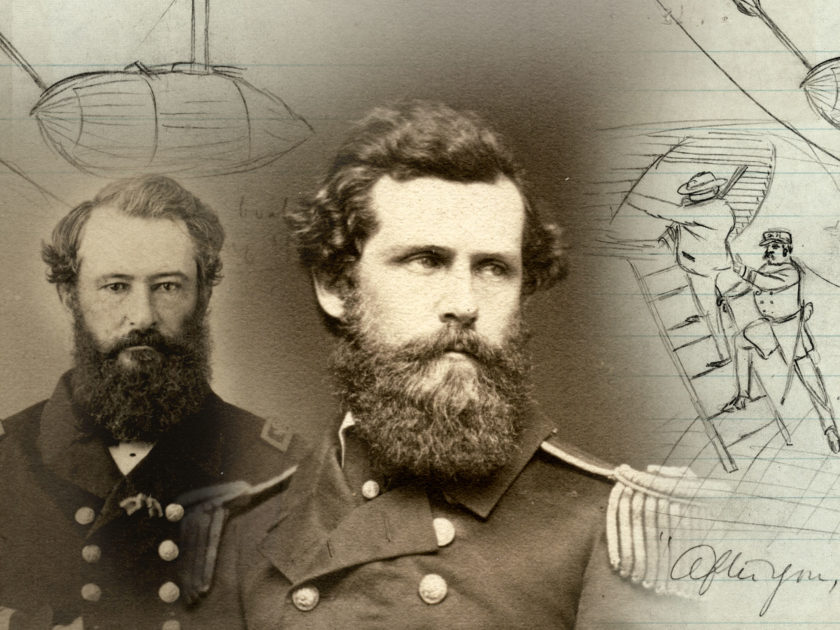By Ronald S. Coddington
Two distinct human stories connected to the 1864 Battle of Mobile Bay have passed through the generations. The protagonists were celebrated as heroes—one a profile of courage and the other of chivalry. Underwater mines, or torpedoes in period vernacular, are central to each account.
The best remembered story involves Rear Adm. David Farragut, the commander of the Union fleet. The stars aligned for him on that August day when his column of iron and wood vessels steamed into the bay. The vision of Farragut lashed with rope to the rigging of his flagship Hartford is indelibly etched into the American memory. His stirring words, paraphrased as “Damn the torpedoes, full speed ahead,” are part of our national vocabulary.

The loss of his lead vessel, the sleek new single-turret ironclad Tecumseh, prompted Farragut’s famous utterance after it struck a torpedo. The commander of this iron giant, Tunis Augustus Macdonough Craven, lies at the heart of the second story and another memorable quote. A New Hampshire native, Craven was an affable, genial man, popular with his fellow officers. He believed the Tecumseh and other vessels of the Monitor design unsafe. And yet, when offered command of the Tecumseh, he set aside his grave misgivings in the interest of the service and accepted the assignment.
So eager was Farragut to have the Tecumseh lead the column at Mobile Bay, he postponed the planned attack date to await the arrival of the vessel en route from the Atlantic coast.
The honor of firing the first shot went to Craven and his crew on August 5 at 6:47 a.m. Less than an hour later, the Tecumseh struck a submerged mine in an underwater field planted by the rebels. A large hole blown through the bottom spelled its doom. Topside in the cramped conning tower stood Craven and his pilot. The exchange between these men is remembered for Craven’s gentlemanly courtesy as the vessel rapidly sunk in a swirling vortex of water. His words, “After you, pilot,” were relayed to John Collins at the base of the ladder leading to the narrow opening of the tower.

History has largely filtered out the moments immediately before and after Craven’s noble gesture, resulting in the loss of important context.
In the 1888 landmark series of volumes Battles and Leaders of the Civil War, Pilot Collins described what happened after the exchange with Craven: “When I reached the upmost round of the ladder, the vessel seemed to drop under me.” And with it went the commander and 93 of his crewmen. This observation lends credence to eyewitness accounts of how quickly the ironclad sank. Estimates range from 30 seconds to a few minutes.
An account in the February 1865 issue of Seamen’s Friend magazine sets the stage for the Craven-Collins encounter. It also includes the variation of Craven’s words most often quoted. The commander “was in the pilot house, with the pilot, as the vessel went down. Each moved instinctively to the ladder, when the gallant Captain stepped one side, exclaiming, ‘You first, sir.’ The pilot rushed down the ladder, got out, and was saved.”
An 1879 account of the encounter offers another version of events. It appeared in A Sketch of the Battle of Mobile Bay by William F. Hutchinson, assistant surgeon of the sloop Lackawanna. “Captain Craven was already partly out, when the pilot grasped him by the leg, and cried ‘Let me get out first, Captain for God’s sake; I have five little children!’ The Captain drew back, saying ‘Go on, sir,’ gave him his place, and went down with the ship while the pilot was saved.”


In August 1898, as the Spanish-American War ended, Atlantic Monthly magazine published “Craven,” a poem by Englishman Henry Newbolt. It includes these verses that echo the accounts published in Seamen’s Friend and Battles and Leaders:
Into the narrowing channel, between the shore
And the sunk torpedoes lying in treacherous rank;
She turned but a yard too short; a muffled roar,
A mountainous wave, and she rolled, righted, and sank.
Over the manhole, up in the iron-clad tower,
Pilot and Captain met as they turned to fly:
The hundredth part of a moment seemed an hour,
For one could pass to be saved, and one must die
They stood like men in a dream: Craven spoke,
Spoke as he lived and fought, with a Captain’s pride,
“After you, Pilot.” The pilot woke,
Down the ladder he went, and Craven died.
In 1900, the U.S. Navy commissioned the torpedo boat Craven, the first of three vessels named for the other hero of Mobile Bay.
Ronald S. Coddington is Editor and Publisher of MI.
SPREAD THE WORD: We encourage you to share this story on social media and elsewhere to educate and raise awareness. If you wish to use any image on this page for another purpose, please request permission.
LEARN MORE about Military Images, America’s only magazine dedicated to showcasing, interpreting and preserving Civil War portrait photography.
VISIT OUR STORE to subscribe, renew a subscription, and more.

